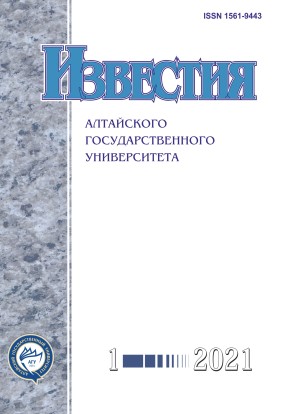Boron Diffusion During Carbon Steel Boriding
УДК 539.212.3
Abstract
Protective boride coatings are obtained by chemical-thermal treatment of powder mixtures during induction furnace heating and micro-arc chemical-thermal treatment. Their usage can significantly increase the reliability and durability of steel products. The calculated composition of the saturating charge and the welding flux used to boride steel 20 samples demonstrates that obtained boride diffusion coatings are characterized by high hardness and an extensive diffusion zone. The most optimal composition of the charge that contains iron and boric acid is found to be in the proportion of Fe-25%+H3BO3-75 %.
The analysis of the distribution of microhardness over the cross section of coated samples is carried out. The comparative data for the diffusion coefficients and the thickness of the diffusion layers obtained experimentally are presented.
The application of the discussed methods makes it possible to intensify the process of diffusion boriding and to ensure the formation of an extensive diffusion zone on the surface of carbon steel products with a high rate of hardening zone formation. The duration of the process is 5 minutes for the induction treatment and 54.05 s for micro-arc chemical-thermal surfacing. It is the main advantage of the experimental techniques mentioned above.
Downloads
Metrics
References
Химико-термическая обработка металлов и сплавов : справочник / под ред. Л.С. Ляховича. М., 1981.
Гурьев А.М., Лыгденов Б.Д., Махаров Д.М., Мосоров В.И. Химико-термическая обработка литой стали // Ползуновский вестник. 2005. № 2.
Лахтин Ю. М. Основы металловедения : учеб. М., 1988.
Лабунец В. Ф. Износостойкие боридные покрытия : справ. пособие. Киев, 1989.
Шевчук Е.П., Плотников В.А., Бектасова Г.С. Рентгеноструктурный анализ диффузионного боридного слоя на углеродистой стали // Известия Алт. гос. ун-та. Физика. 2018. № 4 (102). DOI: 10.14258/izvasu(2018)4-09.
Шевчук Е.П, Плотников В.А., Ахметжанов Б.К. Исследование боридных слоев стали 20 после химико-термической обработки в индукционной печи // Фундаментальные проблемы современного материаловедения. 2018. Т. 15. № 3.
Шевчук Е.П., Плотников В.А., Бектасова Г.С. Исследование диффузионных боридных слоев стали 20, полученных микродуговой наплавкой // Известия Алт. гос. унта. 2020. № 4 (114). DOI: 10.14258/izvasu(2020)4-09.
Урусов В.С. Теоретическая кристаллохимия. М., 1987.
Павлов П.В., Хохлов А.Ф. Физика твердого тела : учеб. ; 3-е изд., стер. М., 2000.
Ормонт Б.Ф. Труды конференции по химии бора и его соединений. M., 1968.
Мерер Х. Диффузия в твердых телах. Долгопрудный, 2011.
Балгазин И.И., Саяпова В.В. Нахождение коэффициента диффузии методом Монте-Карло // Universum: Химия и биология : электрон. научн. журн. 2018. № 5 (47).
Гурьев А.М., Лыгденов Б.Д., Гурьев М.А., Мэй Шунчи, Власова О.А. Борирование малоуглеродистой стали // Международный журнал экспериментального образования. 2015. № 12-4.
Быкова Т.М. Влияние химического состава стали на структуру и свойства диффузионных боридных покрытий : дисс. ... канд. технич. наук : 05.16.09. Екатеринбург, 2016.
Izvestiya of Altai State University is a golden publisher, as we allow self-archiving, but most importantly we are fully transparent about your rights.
Authors may present and discuss their findings ahead of publication: at biological or scientific conferences, on preprint servers, in public databases, and in blogs, wikis, tweets, and other informal communication channels.
Izvestiya of Altai State University allows authors to deposit manuscripts (currently under review or those for intended submission to Izvestiya of Altai State University) in non-commercial, pre-print servers such as ArXiv.
Authors who publish with this journal agree to the following terms:
- Authors retain copyright and grant the journal right of first publication with the work simultaneously licensed under a Creative Commons Attribution License (CC BY 4.0) that allows others to share the work with an acknowledgement of the work's authorship and initial publication in this journal.
- Authors are able to enter into separate, additional contractual arrangements for the non-exclusive distribution of the journal's published version of the work (e.g., post it to an institutional repository or publish it in a book), with an acknowledgement of its initial publication in this journal.
- Authors are permitted and encouraged to post their work online (e.g., in institutional repositories or on their website) prior to and during the submission process, as it can lead to productive exchanges, as well as earlier and greater citation of published work (See The Effect of Open Access).








